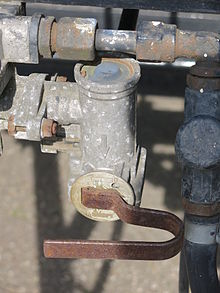Brake force regulator
A brake force regulator is a control valve that is intended to prevent over-braking of axles in motor vehicles or trailers .
When braking a vehicle, the vehicle weight is shifted from the rear axle to the front axle ( dynamic axle load shift ). As a result, the rear wheels have less grip and it is easier for the rear axle to lock. The brake pressure is controlled by the brake force regulator depending on the load condition and the size of the dynamic axle load shift.
Types
- Hydraulic braking system
- In modern cars, the function of a brake force regulator is assumed by the electronic brake force distribution as a sub-function of the anti-lock braking system . Before this, a mechanical brake force limiter with a fixed cut-off pressure to the rear axle was installed (e.g. max. 34 bar).
- Manual brake force regulator (compressed air brake)
- A manual brake force regulator was used on previous trailers . The brake pressure could be manually preselected in four positions (full, half, empty, and release). With “half” the pressure was 4.0–4.5 bar, with “empty” 2.0–2.5 bar.
- Automatically load-dependent brake force regulator
- Automatic load-dependent brake force regulators (ALB) control a variable brake pressure to the rear axle depending on the load status of the rear axle. The load status is communicated to the brake force regulator via a linkage or a spring attached to the rear axle.
Individual evidence
- ↑ Heribert Braun, Günter Kolb: Lkw. A textbook and reference work . 11th edition, Kirschbaum Verlag, Bonn, 2012, ISBN 978-3-7812-1850-5 , p. 190
